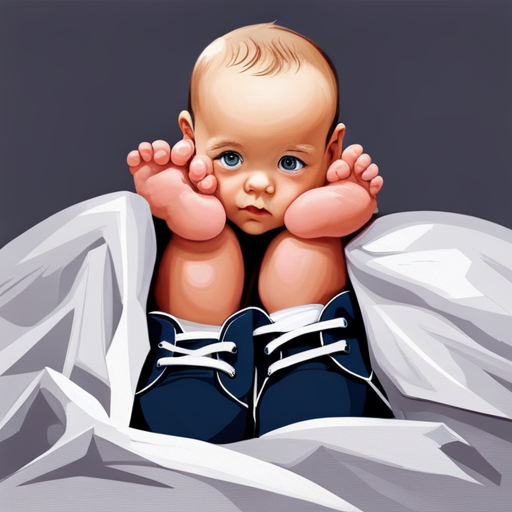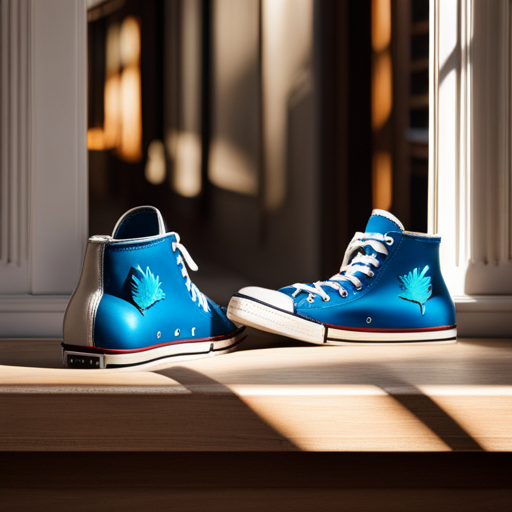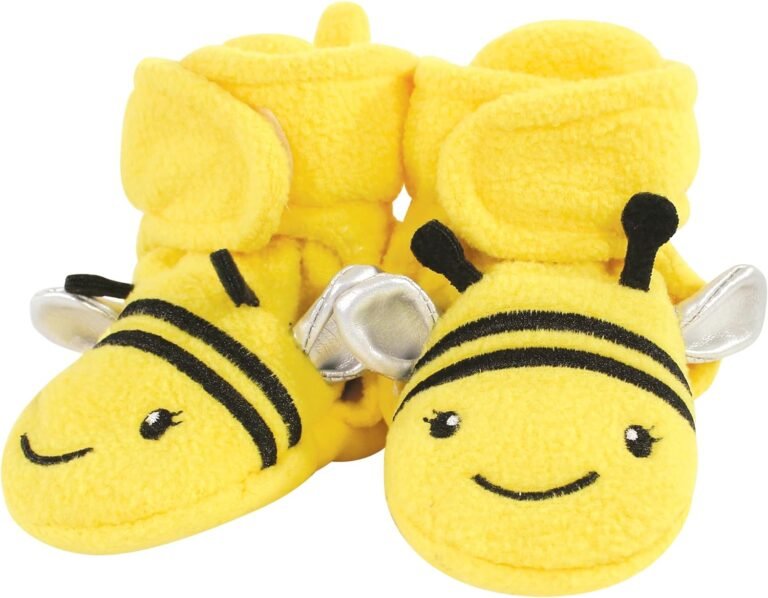Baby’s First Shoes
Are you a new parent wondering when it’s time to buy your baby’s first shoes? Look no further. In this article, we will provide you with a comprehensive guide on everything you need to know about baby shoes.
From sizing and fit to choosing the right material, we will cover it all. Discover popular styles, the importance of proper foot support, and learn how to maintain and clean your baby’s shoes.
Stay tuned for valuable tips and avoid common mistakes when buying baby shoes.
Key Takeaways
- Consider developmental milestones and expert recommendations
- Choose flexible, lightweight shoes with a wide toe box and breathable materials
- Measure feet in the afternoon or evening when they are largest
- Wait until the baby starts walking independently before buying shoes
When to Buy Your Baby’s First Shoes
Before making a decision, it is important to consider the developmental milestones and expert recommendations on when to buy your baby’s first shoes. Baby shoe brands offer a wide range of options, but it is crucial to understand the benefits of barefoot walking before rushing to purchase footwear.
Experts suggest that babies should be allowed to go barefoot as much as possible in the early stages of their development. This is because barefoot walking helps in the natural development of their feet and leg muscles. It allows them to grip the floor with their toes, promoting balance and stability. Moreover, walking barefoot helps in the development of sensory perception, as the soles of the feet are highly sensitive to touch and texture.
However, as your baby starts to explore the world around them and begins to take their first steps, it may be necessary to provide some protection for their feet. This is where baby shoe brands come into play. When choosing the right shoes for your baby, it is important to look for ones that are flexible, lightweight, and have a wide toe box to accommodate their growing feet. Additionally, opt for shoes made from breathable materials to prevent sweating and discomfort.
Sizing and Fit Guide for Baby Shoes
To ensure the proper fit for your baby’s shoes, it is essential to carefully measure their feet using a sizing chart provided by the shoe brand. Finding the right fit for your baby’s shoes is crucial as it directly affects their comfort and overall foot development. Here are some sizing tips to help you find the perfect fit for your little one.
Firstly, measure your baby’s feet in the afternoon or evening when their feet are at their largest. Use a soft tape measure or a piece of string to measure the length of their foot from the heel to the tip of the longest toe. Make sure to measure both feet as they may vary in size.
Next, consult the sizing chart provided by the shoe brand. Each brand may have slightly different sizing, so it’s important to refer to their specific chart. Keep in mind that baby’s feet grow quickly, so it’s recommended to choose shoes that provide a bit of extra room for growth.
When trying on shoes, pay attention to the width and depth as well. The shoes should not be too tight or too loose, and there should be enough space for the toes to wiggle freely. It’s also advisable to choose shoes with a flexible sole to allow natural movement and proper foot development.
Choosing the Right Material for Baby’s Shoes
The durability of the material used in baby’s shoes is a key factor to consider when choosing the right pair for their growing feet. Babies are constantly on the move, exploring their environment and developing their motor skills. Therefore, it is crucial to select shoes that can withstand the wear and tear of their active lifestyle.
When it comes to baby shoe brands, there are a plethora of options available in the market. Some of the popular ones include Nike, Adidas, Puma, Stride Rite, and Robeez. These brands offer a wide range of materials, including leather, mesh, and synthetic fabrics, each with its own benefits and considerations.
Benefits of barefoot walking for babies include improved balance and coordination, enhanced sensory development, strengthened foot muscles, and better overall foot health. Therefore, it is important to choose shoes that mimic the natural feeling of being barefoot, allowing babies’ feet to grow and develop naturally.
Popular Styles for Baby’s First Shoes
Several popular styles, such as Mary Janes and sneakers, are highly sought after for baby’s first shoes. When it comes to choosing the right style for your baby, it is important to consider both comfort and functionality.
Mary Janes are a classic option that offers a cute and stylish look while providing support to the baby’s feet. They typically have a strap across the top of the foot, ensuring a secure fit.
Sneakers, on the other hand, are perfect for active babies who are starting to explore their surroundings. They offer flexibility and grip, allowing the baby to move freely and safely.
When to buy baby’s first shoes is a common concern among parents. It is generally recommended to wait until the baby starts walking independently before purchasing shoes. Until then, it is best to allow the baby to go barefoot or wear soft-soled shoes that promote proper foot development.
Once the baby starts walking, it is important to choose shoes that provide proper support and fit well.
Importance of Proper Foot Support for Babies
One key factor to consider is the significance of providing adequate foot support for babies during their early development stages. The bones and muscles in a baby’s feet are still growing and developing, making it crucial to ensure they have the proper support to promote healthy foot development.
Here are some important reasons why adequate foot support is essential for babies:
- Promotes proper alignment: Proper foot support helps to align the bones and joints in a baby’s feet, promoting correct posture and overall body alignment.
- Enhances balance and stability: Well-supported feet allow babies to develop a strong foundation for balance and stability, enabling them to explore their environment with confidence.
- Supports healthy arch development: Arch support helps the arches in a baby’s feet to develop properly, preventing flat feet and other potential foot problems later in life.
- Reduces discomfort and pain: With proper foot support, babies are less likely to experience discomfort or pain while walking or standing, ensuring a more enjoyable and pain-free experience.
- Supports natural foot development: Allowing babies to walk barefoot or wear soft, flexible shoes that mimic barefoot walking promotes the natural development of the foot muscles and sensory feedback.
When choosing baby shoe brands, it is important to look for those that prioritize adequate foot support and flexibility. By providing the right support for your baby’s feet, you are setting a strong foundation for their future foot health and overall well-being.
Tips for Ensuring Comfort in Baby’s Shoes
A key tip for ensuring comfort in baby’s shoes is to choose brands that prioritize flexibility and provide adequate support. When it comes to selecting the right baby shoe brands, it is important to consider factors such as the materials used, the design, and the closure.
The table below provides a comparison of different closure options commonly found in baby shoes:
| Closure Type | Description |
|---|---|
| Velcro | Easy to fasten and adjust, ideal for babies who are learning to walk |
| Elastic | Offers a secure fit and allows for easy on and off |
| Buckle | Provides a more secure and adjustable closure, suitable for active babies |
| Slip-on | Convenient for quick and easy wearing, but may not provide as secure of a fit |
When selecting the right closure for baby shoes, it is important to consider the needs and preferences of both the baby and the caregiver. For example, Velcro closures are often preferred for their convenience and adjustability, while buckle closures offer a more secure fit for active babies. Elastic closures can provide a balance between ease of use and a secure fit.
How to Maintain and Clean Baby’s Shoes
Regularly cleaning and maintaining baby’s shoes is essential for keeping them in good condition and ensuring their longevity.
Babies are constantly on the move, exploring their surroundings, and their shoes can quickly become dirty and worn out.
Here are some tips on how to maintain and clean baby’s shoes:
-
Use a soft brush or cloth to remove dirt and debris from the shoes. Avoid using harsh chemicals or abrasive materials that could damage the shoes.
-
For leather or suede shoes, use a specialized cleaner and conditioner to keep them looking fresh and prevent cracking or fading.
-
Store baby’s shoes in a cool, dry place to prevent mold or mildew growth. Consider using a shoe organizer or hanging shelves for easy access and to keep them organized.
-
Try using DIY shoe cleaning methods such as a mixture of mild soap and water or a baking soda paste to remove stains and odors. Always test these methods on a small, inconspicuous area first to ensure they don’t damage the shoes.
-
Don’t forget to regularly check the fit of baby’s shoes as their feet grow quickly. Ill-fitting shoes can cause discomfort and hinder proper foot development.
Transitioning From Soft Soled Shoes to Hard Soled Shoes
When transitioning from soft soled shoes to hard soled shoes, it is important to gradually introduce the new shoes to the baby’s feet to ensure comfort and proper foot development. Soft soled shoes have many benefits for babies, such as allowing their feet to develop naturally and providing a good grip on the floor. However, as the baby grows and starts walking more confidently, it becomes necessary to transition to hard soled shoes for added support and protection.
To make the transitioning process smooth and comfortable for the baby, it is recommended to follow a gradual approach. Start by allowing the baby to wear the hard soled shoes for short periods of time, such as during playtime at home. Over time, increase the duration of wearing the shoes until the baby is comfortable wearing them for longer periods. It is also important to check the fit of the shoes regularly to ensure they are not too tight or too loose.
Below is a table highlighting the benefits of soft soled shoes and the steps to transition to hard soled shoes:
| Benefits of Soft Soled Shoes | Transitioning to Hard Soled Shoes |
|---|---|
| Promote natural foot development | Start by wearing for short periods |
| Allow for better grip on the floor | Gradually increase wearing duration |
| Provide flexibility and comfort | Check fit regularly |
| Let baby’s feet breathe | Ensure shoes are not too tight or loose |
Common Mistakes to Avoid When Buying Baby Shoes
To avoid common mistakes, carefully research and compare different baby shoe brands and styles before making a purchase. Choosing the right shoe size for your baby is crucial to ensure their comfort and proper development. Here are some common mistakes to avoid when buying baby shoes:
-
Ignoring the importance of measuring your baby’s feet: Babies’ feet grow rapidly, so it’s essential to measure their feet regularly to ensure you’re buying the correct size. Neglecting this step can lead to discomfort and potential foot problems.
-
Prioritizing style over functionality: While cute designs may be tempting, it’s important to prioritize functionality and support when selecting baby shoes. Look for brands that offer features like flexible soles, adjustable closures, and breathable materials for optimal comfort.
-
Buying shoes that are too big or too small: Avoid the temptation to buy shoes that your baby will ‘grow into.’ Ill-fitting shoes can hinder their natural foot development and cause discomfort. Always choose shoes that fit properly at the time of purchase.
-
Not considering the shoe’s construction: Look for shoes with a sturdy construction that provides proper support for your baby’s growing feet. Avoid shoes with stiff soles or those that restrict movement.
-
Neglecting to read reviews and recommendations: Before making a purchase, take the time to read reviews and recommendations from other parents. This can provide valuable insights into the quality and performance of different baby shoe brands.
Finding Affordable and High-Quality Baby Shoes
Both affordability and high quality are important factors to consider when searching for baby shoes. Parents want to provide their little ones with shoes that are comfortable, durable, and long-lasting, while also being mindful of their budget. Fortunately, there are affordable options available in the market that offer excellent quality.
To help parents make an informed decision, here is a comparison table showcasing five popular baby shoe brands known for their affordability, durability, and longevity:
| Brand | Price Range | Material | Features | Customer Reviews |
|---|---|---|---|---|
| Brand A | $-$$ | Leather | Soft sole, adjustable straps | Positive |
| Brand B | $-$$ | Fabric | Lightweight, non-slip sole | Highly recommended |
| Brand C | $-$$ | Synthetic | Breathable, easy to clean | Great value for money |
| Brand D | $-$$ | Canvas | Flexible, wide toe box | Durable and comfortable |
| Brand E | $-$$ | Rubber | Waterproof, traction outsole | Reliable and long-lasting |
Frequently Asked Questions
Are Baby Shoes Necessary for Infants Who Are Not Walking Yet?
It is not necessary for infants who are not walking yet to wear baby shoes. In fact, it is beneficial for their foot development to allow them to go barefoot or wear soft soled shoes to promote natural foot movement and strength.
Can I Use Hand-Me-Down Shoes for My Baby?
When considering hand-me-down shoes for your baby, it is important to prioritize their safety. Ensure that the shoes fit properly and do not pose any risks, such as loose parts or worn-out soles. Regularly inspect the shoes for potential hazards.
What Are the Potential Risks of Buying Ill-Fitting Shoes for My Baby?
Potential long term effects of buying ill-fitting shoes for a baby include foot deformities, discomfort, and impaired foot development. Proper shoe sizing is important to ensure the baby’s feet have room to grow and develop properly, promoting healthy foot development.
How Often Should I Measure My Baby’s Feet to Ensure Proper Shoe Size?
Regularly measuring your baby’s feet is crucial to ensure they are wearing the correct shoe size. Consult baby shoe sizing charts and follow proper measurement techniques to accurately determine their size and avoid potential discomfort or developmental issues.
Are There Specific Shoe Styles That Are Recommended for Babies With Wide or Narrow Feet?
When it comes to baby shoe sizing, it is important to consider the width of their feet. There are specific shoe styles and brands that are recommended for babies with wide or narrow feet, ensuring proper fit and comfort.
Conclusion
In conclusion, it is essential for parents to carefully consider various factors when purchasing their baby’s first shoes.
From choosing the right size and material to ensuring proper foot support, these decisions can greatly impact a baby’s comfort and development.
Additionally, properly maintaining and cleaning the shoes, as well as transitioning from soft soled to hard soled shoes, are important aspects to consider.
By avoiding common mistakes and finding affordable, high-quality options, parents can provide their babies with the best footwear for their growing feet.








